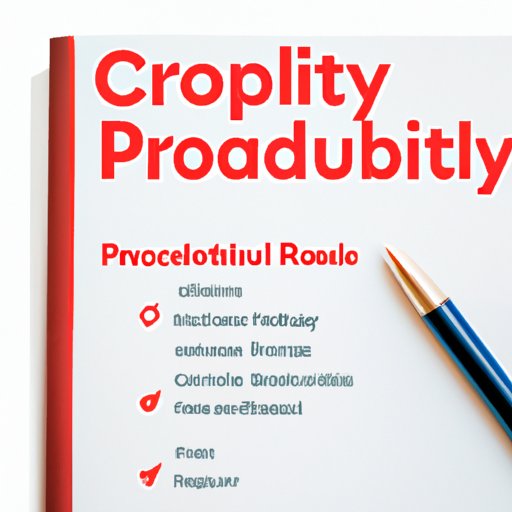
I. Introduction
Reports are a vital aspect of business operations, academic studies, and research projects. Writing an effective report means producing a document that communicates information clearly and accurately and contributes to the decision-making process. This article provides a comprehensive guide to report writing for professionals in any field.
II. 8 Essential Steps for Writing an Effective Report
Writing a report involves several essential steps:
Step 1: Define the purpose and scope of the report
Before starting the writing process, define what you want to achieve with your report. Clarify the scope of the report and identify the key questions you want to answer.
Step 2: Analyze your audience and tailor your approach accordingly
Understand who your audience is and tailor your approach to meet their needs. Consider their level of knowledge, interests, and attitudes toward the subject matter.
Step 3: Conduct thorough research and gather all relevant information
Conduct thorough research on the subject matter and gather all relevant data and information. Use reliable sources to ensure the accuracy of your report.
Step 4: Organize your findings and develop a clear structure
Organize your findings and develop a clear structure for your report. Use headings and subheadings to provide a logical and clear flow of information.
Step 5: Use effective writing techniques to convey information
Use effective writing techniques to convey information clearly and concisely. Use active voice, avoid jargon, and write in a tone appropriate for your audience.
Step 6: Edit and proofread your report for clarity and accuracy
Edit and proofread your report to ensure clarity and accuracy. Check for spelling and grammatical errors, and ensure that all information is correct and up-to-date.
Step 7: Include visuals and appendices for clarity and completeness
Use visuals, tables, and charts to illustrate your findings and make them easier to understand. Include appendices with supporting information and data for completeness.
Step 8: Finalize your report and distribute it to the relevant parties
Finalize your report and distribute it to the relevant parties. Ensure that all parties receive the report in a timely manner and that it is easily accessible.
III. A Comprehensive Guide to Writing Clear and Concise Reports
Define clarity and conciseness in report writing
Clarity and conciseness are essential elements of effective report writing. Clarity means that your report is easy to understand, while conciseness means that you communicate information in a precise and direct manner.
Discuss tips for achieving clarity and conciseness
To achieve clarity and conciseness, use simple and direct language and avoid unnecessary words and phrases. Use bullet points and subheadings to break up text and highlight key information. Write in an active voice and present information in a logical and organized manner.
Provide examples and case studies to illustrate how to write clear and concise reports
One example of clear and concise writing is a financial report that uses charts and graphs to present data. Another example is a business plan that includes an executive summary to provide a concise overview of the main points.

IV. Maximize Your Productivity: Tips for Organizing Your Report Writing Process
Define productivity in report writing
Productivity in report writing means managing your time effectively and producing high-quality work efficiently.
Discuss tips for managing time and staying organized
To maximize productivity, develop a schedule for your report writing process and adhere to it. Set realistic deadlines and prioritize tasks based on importance. Use tools such as project management software, productivity apps, and time-tracking tools to stay organized and on track.
Provide examples of tools and techniques for boosting productivity
Tools such as Trello, Asana, and Evernote can help you stay organized and efficient. Time-tracking tools like RescueTime and Harvest can help you track time spent on specific tasks and determine areas where you can improve efficiency.
V. How to Write a Report that Delivers Results
Discuss the importance of writing reports that deliver results
Writing reports that deliver results means producing a document that leads to action and decision-making. The report must provide clear recommendations and actionable steps.
Define results-oriented writing and provide tips for achieving it
Results-oriented writing means focusing on the outcomes of your report and crafting it with the intention of achieving those outcomes. To achieve results-oriented writing, focus on the main goal of your report and structure it in a way that leads to decision-making and action. Provide clear recommendations and highlight the main takeaways.
Provide examples and case studies to illustrate how to write reports that deliver results
One example of results-oriented writing is a market research report that provides clear recommendations for a new product launch. Another example is a feasibility study that presents different options and recommends the best course of action.
VI. The Do’s and Don’ts of Report Writing: A Simple Guide
Define common mistakes made in report writing
Common mistakes in report writing include using overly complex language, presenting irrelevant information, and failing to structure the report effectively.
Discuss tips for avoiding common mistakes
To avoid common mistakes, focus on using clear and concise language and only including relevant information. Structure the report with headings and subheadings to help the reader navigate the information.
Provide examples of do’s and don’ts in report writing
Do use bullet points and subheadings to break up text and highlight key information. Don’t use jargon or overly complex language that may confuse the reader. Do present information in a logical and organized manner. Don’t present irrelevant information that may distract from the main point of the report.
VII. From Research to Conclusion: The Fundamentals of Report Writing
Discuss the importance of research in report writing
Research is essential in report writing to ensure the accuracy and validity of the report. It also provides the necessary background information for the subject matter.
Define the key components of a report (introduction, body, and conclusion)
The introduction of a report provides background information and states the purpose of the report. The body of the report presents the findings and analysis. The conclusion summarizes the main points and provides recommendations.
Provide tips for writing each component effectively
To write an effective introduction, provide background context and state the purpose of the report. To write an effective body, use headings and subheadings to organize the information and present it in a logical and clear manner. To write an effective conclusion, summarize the main points and provide clear recommendations.
VIII. Mastering the Art of Report Writing: Tips from Seasoned Professionals
Discuss the importance of learning from seasoned professionals
Learning from seasoned professionals can provide valuable insights and tips for effective report writing.
Provide tips and advice from experienced professionals in report writing
Experienced professionals recommend focusing on the purpose of the report, using clear and concise language, and presenting information in a logical and organized manner. They also recommend editing and proofreading thoroughly to ensure accuracy and clarity.
IX. Conclusion
Writing an effective report requires careful planning, research, and organization. By following the essential steps outlined in this article, writers can produce reports that communicate information clearly and accurately and contribute to the decision-making process. Remember to focus on clarity, conciseness, and results-oriented writing, and to always seek feedback and learn from experienced professionals in the field.




